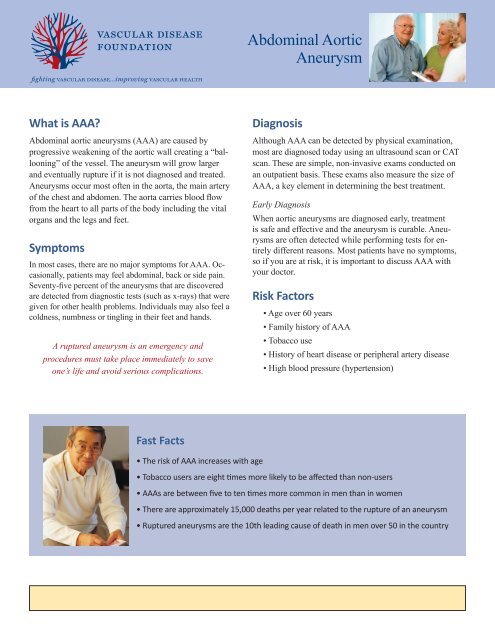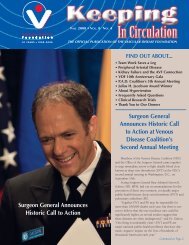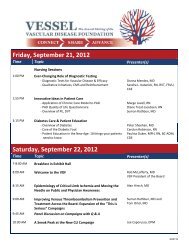Abdominal Aortic Aneurysm or AAA - Vascular Disease Foundation
Abdominal Aortic Aneurysm or AAA - Vascular Disease Foundation
Abdominal Aortic Aneurysm or AAA - Vascular Disease Foundation
Create successful ePaper yourself
Turn your PDF publications into a flip-book with our unique Google optimized e-Paper software.
<strong>Abdominal</strong> <strong>A<strong>or</strong>tic</strong><br />
<strong>Aneurysm</strong><br />
What is <strong>AAA</strong><br />
<strong>Abdominal</strong> a<strong>or</strong>tic aneurysms (<strong>AAA</strong>) are caused by<br />
progressive weakening of the a<strong>or</strong>tic wall creating a “ballooning”<br />
of the vessel. The aneurysm will grow larger<br />
and eventually rupture if it is not diagnosed and treated.<br />
<strong>Aneurysm</strong>s occur most often in the a<strong>or</strong>ta, the main artery<br />
of the chest and abdomen. The a<strong>or</strong>ta carries blood flow<br />
from the heart to all parts of the body including the vital<br />
<strong>or</strong>gans and the legs and feet.<br />
fighting VASCULAR DISEASE...improving VASCULAR HEALTH<br />
Symptoms<br />
In most cases, there are no maj<strong>or</strong> symptoms f<strong>or</strong> <strong>AAA</strong>. Occasionally,<br />
patients may feel abdominal, back <strong>or</strong> side pain.<br />
Seventy-five percent of the aneurysms that are discovered<br />
are detected from diagnostic tests (such as x-rays) that were<br />
given f<strong>or</strong> other health problems. Individuals may also feel a<br />
coldness, numbness <strong>or</strong> tingling in their feet and hands.<br />
A ruptured aneurysm is an emergency and<br />
procedures must take place immediately to save<br />
one’s life and avoid serious complications.<br />
Diagnosis<br />
Although <strong>AAA</strong> can be detected by physical examination,<br />
most are diagnosed today using an ultrasound scan <strong>or</strong> CAT<br />
scan. These are simple, non-invasive exams conducted on<br />
an outpatient basis. These exams also measure the size of<br />
<strong>AAA</strong>, a key element in determining the best treatment.<br />
Early Diagnosis<br />
When a<strong>or</strong>tic aneurysms are diagnosed early, treatment<br />
is safe and effective and the aneurysm is curable. <strong>Aneurysm</strong>s<br />
are often detected while perf<strong>or</strong>ming tests f<strong>or</strong> entirely<br />
different reasons. Most patients have no symptoms,<br />
so if you are at risk, it is imp<strong>or</strong>tant to discuss <strong>AAA</strong> with<br />
your doct<strong>or</strong>.<br />
Risk Fact<strong>or</strong>s<br />
• Age over 60 years<br />
• Family hist<strong>or</strong>y of <strong>AAA</strong><br />
• Tobacco use<br />
• Hist<strong>or</strong>y of heart disease <strong>or</strong> peripheral artery disease<br />
• High blood pressure (hypertension)<br />
Fast Facts<br />
• The risk of <strong>AAA</strong> increases with age<br />
• Tobacco users are eight times m<strong>or</strong>e likely to be affected than non-users<br />
• <strong>AAA</strong>s are between five to ten times m<strong>or</strong>e common in men than in women<br />
• There are approximately 15,000 deaths per year related to the rupture of an aneurysm<br />
• Ruptured aneurysms are the 10th leading cause of death in men over 50 in the country
Causes<br />
Proteins in the wall of the a<strong>or</strong>ta, called elastin and collagen<br />
provide strength and flexibility to this large artery. This is<br />
similar to muscles and tendons providing strength to the arms<br />
and legs. <strong>Aneurysm</strong>s are caused by a progressive breakdown<br />
of these proteins that lead to a weakness of the wall of the<br />
a<strong>or</strong>ta that can steadily expand like a balloon. These proteins,<br />
collagen and elastin, may gradually deteri<strong>or</strong>ate with age.<br />
Inflammation that is associated with atherosclerosis (hardening<br />
of the arteries) helps to accelerate this degenerative<br />
process even in younger people. Some of the body’s naturally<br />
occurring enzymes may also cause the breakdown of collagen<br />
and elastin in the wall of the a<strong>or</strong>ta. An excess of these<br />
enzymes <strong>or</strong> conditions that activate the enzymes may cause<br />
the f<strong>or</strong>mation of an aneurysm, <strong>or</strong> lead to its sudden growth.<br />
In rare cases an aneurysm may be caused by infection. There<br />
is still much to be learned about the cause of aneurysms and<br />
their growth.<br />
Treatment<br />
If the <strong>AAA</strong> is larger than 5-6 centimeters in diameter (about<br />
the size of a lemon), it will require treatment. Your physician’s<br />
decision to repair will be based on the risk of the aneurysm<br />
rupturing, along with surgical <strong>or</strong> procedure risks, and<br />
risks associated with other pre-existing conditions. Smaller<br />
aneurysms that cause back <strong>or</strong> abdominal pain may also need<br />
treatment, especially f<strong>or</strong> those that are enlarging rapidly.<br />
Surgical treatment of <strong>AAA</strong> has been perf<strong>or</strong>med routinely<br />
in the U.S. f<strong>or</strong> about 50 years. It is a very successful and<br />
durable procedure. During the surgery, the surgeon makes<br />
an abdominal incision, then replaces the diseased part of the<br />
a<strong>or</strong>ta with a Dacron <strong>or</strong> Teflon graft that is carefully matched<br />
to the n<strong>or</strong>mal a<strong>or</strong>ta. This graft is sewn in place by the surgeon.<br />
Most patients stay in the hospital f<strong>or</strong> five to ten days if<br />
no complications occur. Complete recovery from the operation<br />
may take one to two months bef<strong>or</strong>e returning to a full<br />
and n<strong>or</strong>mal life.<br />
After 50 years of experience with these procedures, the<br />
facts show that m<strong>or</strong>e than 90 percent of patients make a<br />
full recovery from surgery. Once patients have recovered,<br />
their aneurysms are permanently cured!<br />
Less Invasive Treatments of <strong>AAA</strong><br />
Recent advances in catheter-based technologies have led<br />
to exciting new treatments f<strong>or</strong> a<strong>or</strong>tic aneurysms. Now, endovascular<br />
grafting technology allows the repair of the <strong>AAA</strong><br />
by inserting a graft through a small incision in the groin. The<br />
endovascular method allows the graft to be delivered through<br />
a catheter <strong>or</strong> tube inserted in a groin artery. X-ray guidance<br />
is then used to accurately position the graft in the <strong>AAA</strong>. The<br />
graft is then expanded inside the a<strong>or</strong>ta and held in place with<br />
metallic hooks rather than sutures. The hospital stay is usually<br />
only one <strong>or</strong> two days, and most patients can return to w<strong>or</strong>k<br />
<strong>or</strong> n<strong>or</strong>mal daily activities in about a week. Patients with other<br />
medical problems <strong>or</strong> those that could not withstand maj<strong>or</strong><br />
surgery can be considered f<strong>or</strong> repair by an endovascular graft.<br />
Endovascular grafting may not be possible in every case.<br />
Endovascular grafts are specially manufactured and don’t “fit”<br />
everyone’s anatomical situation. Standard surgery may still be<br />
the best option f<strong>or</strong> many. As a fairly new procedure, endografts<br />
do not yet have a 50-year track rec<strong>or</strong>d to compare to<br />
that of surgery f<strong>or</strong> <strong>AAA</strong>. Speak with your physician about the<br />
best option f<strong>or</strong> you.<br />
The combination of early diagnosis with safer, simpler,<br />
and ever m<strong>or</strong>e successful treatments can prevent deaths<br />
due to ruptured abdominal a<strong>or</strong>tic aneurysms.<br />
The <strong>Vascular</strong> <strong>Disease</strong> <strong>Foundation</strong><br />
Established in 1998, the <strong>Vascular</strong> <strong>Disease</strong> <strong>Foundation</strong> (VDF) develops<br />
educational inf<strong>or</strong>mation and initiatives f<strong>or</strong> patients, their families and<br />
friends, and health care providers regarding often ign<strong>or</strong>ed, but serious<br />
vascular diseases. In fact, VDF is the only multidisciplinary national<br />
public 501(c)(3) non-profit <strong>or</strong>ganization focused on providing public<br />
education and improving awareness about vascular diseases.<br />
F<strong>or</strong> m<strong>or</strong>e inf<strong>or</strong>mation, visit vasculardisease.<strong>or</strong>g.<br />
Help the <strong>Vascular</strong> <strong>Disease</strong> <strong>Foundation</strong> continue to make this critical educational<br />
inf<strong>or</strong>mation available. Your contribution will make saving lives a greater reality.<br />
Make a donation today at: contact.vasculardisease.<strong>or</strong>g/donate<br />
To find out m<strong>or</strong>e about the <strong>Vascular</strong> <strong>Disease</strong> <strong>Foundation</strong>, call 888.833.4463 <strong>or</strong> visit us online at www.vasculardisease.<strong>or</strong>g<br />
© 2012 VASCULAR DISEASE FOUNDATION 8206 Leesburg Pike, Suite 301 • Vienna, VA 22182 01vdf2012







